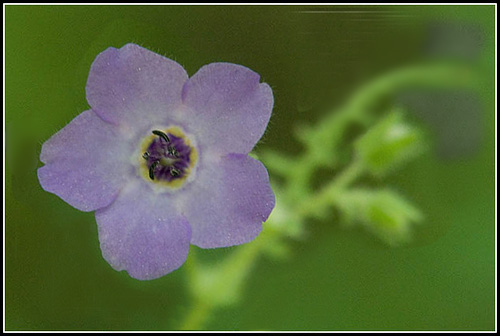Mike Spinak
pro member
This is a Blue Fiesta, Pholistoma auritum var. auritum.
I chose to show this small flower with a simple composition employing three distinct layers of focus, with the main subject matter (the flower) offset a little to the left, and the secondary subject matter (the rest of the plant) offset a little to the right.
The nearest of the three layers, the purple flower, is fully focused; the middle, the stems, leaves, and buds, are blurred so all detail is lost, but the shapes are still recognizable; and the background is blurred utterly. I chose to use this presentation to bring strong emphasis to the flower... to make it seem to almost emerge from the picture. I wanted the presentation of the secondary subject matter to be just enough to suggest the rest, without competing with the flower. I wanted to present the background in a manner that gives ambience, but doesn't give any recognizable material to compete with any of the subject matter.
Blue fiesta works well for this composition, because the broad, flattish flowers make it easier to get the whole flower (Or, at least, the edges and the center) in focus. The long, narrow, fairly straight stems make it easier to neatly separate the near field of full focus from the middle field of partial focus, with little gradual transition between them. Darker colors behind the subjects help prevent the background from distracting. Dim light makes it easier to get the very shallow depth of field necessary to make this kind of picture work. I used as small of an aperture as necessary to get the foreground flower within the depth of field, but no smaller... I kept the aperture as large as possible.
I used a long lens (300 mm, plus a 1.4 teleconverter, for a total of 420 mm focal length), to isolate the plant from its surroundings, and used extension tubes to allow closer focus.
I used the depth of field preview to get the depth of field as I wanted.
I underexposed the picture slightly, and then selectively oversharpened it, to add some noise/grain, to give the middleground and background layers a somewhat dreamy look of separateness.
I hope you enjoy it.

© Mike Spinak
www.mikespinak.com
I chose to show this small flower with a simple composition employing three distinct layers of focus, with the main subject matter (the flower) offset a little to the left, and the secondary subject matter (the rest of the plant) offset a little to the right.
The nearest of the three layers, the purple flower, is fully focused; the middle, the stems, leaves, and buds, are blurred so all detail is lost, but the shapes are still recognizable; and the background is blurred utterly. I chose to use this presentation to bring strong emphasis to the flower... to make it seem to almost emerge from the picture. I wanted the presentation of the secondary subject matter to be just enough to suggest the rest, without competing with the flower. I wanted to present the background in a manner that gives ambience, but doesn't give any recognizable material to compete with any of the subject matter.
Blue fiesta works well for this composition, because the broad, flattish flowers make it easier to get the whole flower (Or, at least, the edges and the center) in focus. The long, narrow, fairly straight stems make it easier to neatly separate the near field of full focus from the middle field of partial focus, with little gradual transition between them. Darker colors behind the subjects help prevent the background from distracting. Dim light makes it easier to get the very shallow depth of field necessary to make this kind of picture work. I used as small of an aperture as necessary to get the foreground flower within the depth of field, but no smaller... I kept the aperture as large as possible.
I used a long lens (300 mm, plus a 1.4 teleconverter, for a total of 420 mm focal length), to isolate the plant from its surroundings, and used extension tubes to allow closer focus.
I used the depth of field preview to get the depth of field as I wanted.
I underexposed the picture slightly, and then selectively oversharpened it, to add some noise/grain, to give the middleground and background layers a somewhat dreamy look of separateness.
I hope you enjoy it.

© Mike Spinak
www.mikespinak.com
Last edited:

